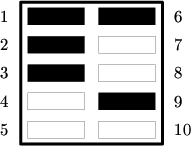Difference between revisions of "1988 AIME Problems"
Diophantient (talk | contribs) m (→Problem 2) |
(→Problem 9) |
||
| Line 35: | Line 35: | ||
== Problem 9 == | == Problem 9 == | ||
| + | Find the smallest positive integer whose [[perfect cube|cube]] ends in <tt>888</tt>. | ||
[[1988 AIME Problems/Problem 9|Solution]] | [[1988 AIME Problems/Problem 9|Solution]] | ||
Revision as of 13:47, 24 October 2007
Contents
Problem 1
One commercially available ten-button lock may be opened by depressing -- in any order -- the correct five buttons. The sample shown below has ![]() as its combination. Suppose that these locks are redesigned so that sets of as many as nine buttons or as few as one button could serve as combinations. How many additional combinations would this allow?
as its combination. Suppose that these locks are redesigned so that sets of as many as nine buttons or as few as one button could serve as combinations. How many additional combinations would this allow?

Problem 2
For any positive integer ![]() , let
, let ![]() denote the square of the sum of the digits of
denote the square of the sum of the digits of ![]() . For
. For ![]() , let
, let ![]() . Find
. Find ![]() .
.
Problem 3
Problem 4
Problem 5
Problem 6
Problem 7
Problem 8
Problem 9
Find the smallest positive integer whose cube ends in 888.









